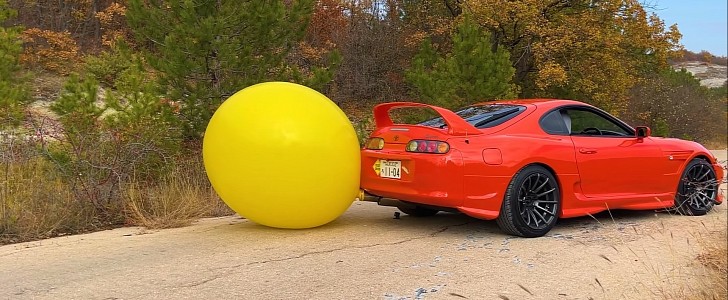The fourth-generation Supra is many things to just as many people. For Superkot, the gentleman behind the namesake YouTube channel specialized in fun and crazy experiments, the ultra-collectible MKIV is nothing more than a glorified balloon popper in the featured video.
The additional back pressure created by the giant balloon affixed to the exhaust tailpipe is insignificant, more so if you remember what kind of engine the Supra has. We also have to remember that an internal combustion engine goes through more air every minute than human lungs, and lest we forget, the 2JZ has been proven to insane figures with the stock internals.
Superkot’s newest upload also reminded me of two videos from Warped Perception, a channel that mounted GoPro cameras inside one of the rear tires and inside the intake manifold of a fourth-generation Toyota Supra.
Codenamed A80, the MKIV was produced between the 1993 and 2002 model years with two engine choices. The free-breathing GE version of the 2JZ flexes 222 horsepower and 209 pound-feet (284 Nm) of torque, pretty respectable numbers for that era and for the base price of $34,225.
The GTE twin-turbo variant was originally rated at 276 horsepower and 318 pound-feet (431 Nm) of torque in Japan or 320 ponies and 315 pound-feet (427 Nm) in the United States. European models had a little more horsepower (325) while late JDM models had the upper hand in terms of torque (333 pound-feet or 451 Nm) thanks to the addition of VVT-i tech.
Including the pre-production cars, the MKIV numbers – or used to number – 45,230 examples of the breed. Most of them (31,575 units) were sold in Japan while the United States of America is ranked second (11,446 units).
Codenamed J29 in BMW jargon, the fifth-generation Supra just doesn’t hold a candle to its predecessor although the CLAR-based platform, B58 engine, and ZF 8HP eight-speed gearbox are perfect for this application.
Superkot’s newest upload also reminded me of two videos from Warped Perception, a channel that mounted GoPro cameras inside one of the rear tires and inside the intake manifold of a fourth-generation Toyota Supra.
Codenamed A80, the MKIV was produced between the 1993 and 2002 model years with two engine choices. The free-breathing GE version of the 2JZ flexes 222 horsepower and 209 pound-feet (284 Nm) of torque, pretty respectable numbers for that era and for the base price of $34,225.
The GTE twin-turbo variant was originally rated at 276 horsepower and 318 pound-feet (431 Nm) of torque in Japan or 320 ponies and 315 pound-feet (427 Nm) in the United States. European models had a little more horsepower (325) while late JDM models had the upper hand in terms of torque (333 pound-feet or 451 Nm) thanks to the addition of VVT-i tech.
Including the pre-production cars, the MKIV numbers – or used to number – 45,230 examples of the breed. Most of them (31,575 units) were sold in Japan while the United States of America is ranked second (11,446 units).
Codenamed J29 in BMW jargon, the fifth-generation Supra just doesn’t hold a candle to its predecessor although the CLAR-based platform, B58 engine, and ZF 8HP eight-speed gearbox are perfect for this application.












